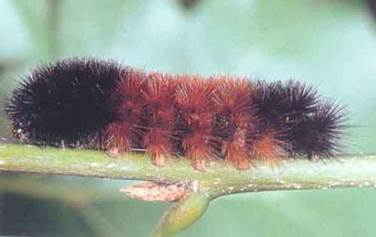..... looks like it's a-gonna be a loooong Winter in Coopville!
Woolly Bear Caterpillar: A Winter Weather Predictor or Not?
| Most people in the Midwest or New England have heard at one time or another that if you want a forecast for the upcoming winter that you should just look for a woolly bear (black at both ends and a reddish brown or rust colored in the middle) or fuzzy bear caterpillar. This same caterpillar is called the woolly worm in southern United States. Yet another name for this caterpillar is the Hedgehog Caterpillar, because it curls into a tight bristly ball and “plays dead” when picked up or disturbed. Whatever name they go by, they are often found in the autumn after they have left their food plants (variety of grasses and weeds including plantain, dandelion, and nettles) in search of a dark and sheltered spot where they can hibernate as larvae for the winter. |  The Woolly Bear (Pyrrharctia isabella) Caterpillar is found across the United States, Canada, and Mexico. |
Woolly Bear Folklore:
According to folklore, the amount of black on the woolly bear in autumn varies proportionately with the severity of the coming winter in the locality where the caterpillar is found. The longer the woolly bear's black bands, the longer, colder, snowier, and more severe the winter will be.Similarly, the wider the middle brown band is associated with a milder upcoming winter. The position of the longest dark bands supposedly indicates which part of winter will be coldest or hardest. If the head end of the caterpillar is dark, the beginning of winter will be severe. If the tail end is dark, the end of winter will be cold. In addition, the woolly bear caterpillar has 13 segments to its body, which traditional forecasters say correspond to the 13 weeks of winter.
As with most folklore, there are 2 other versions to this story. The first one says that the woolly bear caterpillar's coat will indicate the upcoming winter's severity. So, if its coat is very woolly, it will be a cold winter. The final version deals with the woolly bear caterpillar's direction of travel of the worms. It is said that woolly bear's crawling in a southerly direction are trying to escape the cold winter conditions of the north. On the other hand, woolly bear's crawling on a northward path would indicate a mild winter.
:o(
All black ones don't count; they're a separate species! - lol - That's my story and I'm stickin' with it!
ReplyDeleteWhewww! Thanks Gorges - I was getting worried! :o)
Delete